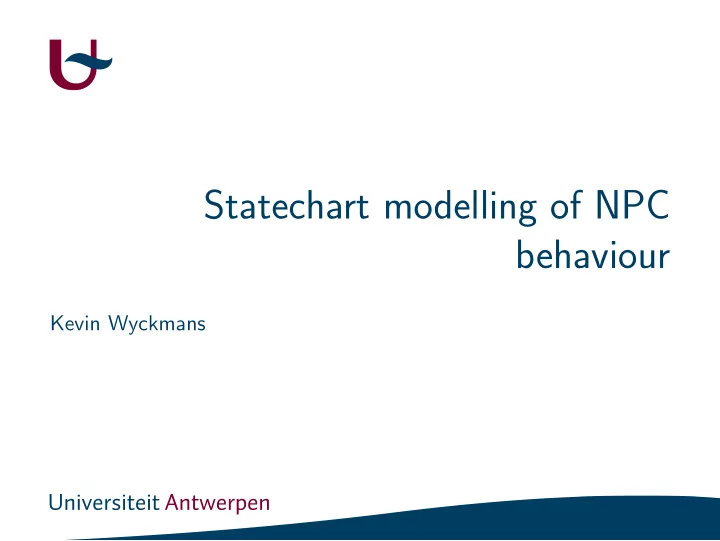

Statechart modelling of NPC behaviour Kevin Wyckmans
Overview Introduction Case study: Tank Wars Modelling Game AI Time Code generation Agent based spreading of diseases 2/25
Introduction As the realism in games increases, so does the demand for more sophisticated AI. This leads to more complex code. We can abstract this to a higher level: ◮ Define REACTIONS for NPC’s on game EVENTS ⇒ Statecharts 3/25
Overview Introduction Case study: Tank Wars Modelling Game AI Time Code generation Agent based spreading of diseases 4/25
Structure of our models Based on paper written by Jrg Kienzle, Alexandre Denault and Hans Vangheluwe: Model-Based Design of Computer-Controlled Game Character Behavior ◮ Character uses sensors to detect events. ◮ Reacts using actions or actuators ◮ Describe transformation of sensor input to actuator output using simple components. ◮ Structure defined by class diagrams ◮ behaviour defined by statecharts ◮ Communicate using asynch. events. 5/25
Different abstraction levels 6/25
Sensors ◮ State of tank and it’s components evolve. ◮ Explicitly model generation of events using state diagrams ◮ Attach to class that contains all the state necessary 7/25
More complex example... 8/25
Analyzers ◮ Some events depend on multiple tank components ◮ Enemy in range? 9/25
Memorizers ◮ Make descisions based on events from the past ◮ Occurances of events can be remembered using attributes or statecharts ◮ Sometimes elaborate data structures necessary (maps, ...) 10/25
Strategical and Tactical Deciders ◮ Strategical Decider: Decides on what goal to achieve ◮ Tactical Decider: How to achieve that goal ◮ This can be very complex! ◮ Each strategy should have a corresponding planner. 11/25
Strategical decisions 12/25
Tactical decisions 13/25
Executors ◮ Maps the decisions of tactical deciders to events that the actuators understand ◮ Convert waypoints into directions, . . . ◮ Can be made more complex by taking physics into account 14/25
Coordinators ◮ Executors map events directly to actuators ⇒ Might lead to inefficient and even incorrect behaviour ◮ Example: Turning of turret while attacking 15/25
Actuators ◮ At this level of abastraction: very simple actuators ◮ Each actuator is a seperate control class 16/25
17/25
Time Slicing ◮ Time-slicing vs. continuous time ◮ Statecharts purely eveny based ◮ On model level: Time is continuous ◮ Modelling freedom ◮ Symbolic analysis ◮ Simulation ◮ Reuse ◮ This has to be mapped to the target simulation ◮ If the slice is small enough, the approximation is acceptable 18/25
Bridging the gap ◮ Every slice a function with updated data is called ◮ Fill objects with new data ◮ map data to events using sensors ⇒ starting here, propagation/triggering of events done entirely in statechart ◮ If all events finished or just before slice ends, return the necessary commands 19/25
From statecharts to code ◮ Use atom 3 to model statecharts ◮ Use a statechart compiler to generate code 20/25
Overview Introduction Case study: Tank Wars Modelling Game AI Time Code generation Agent based spreading of diseases 21/25
Overview ◮ Correlates to Roland’s project ◮ Visualisation of agent based spreading of an infectious disease ◮ Comparable to the system described above. ◮ The same abstraction levels are adequate. ◮ Sensors: eyes, Actuators: legs, . . . 22/25
Scientific possibilities ◮ Visualise the behaviour of people using various algorithms ◮ Use probabilities to introduce randomness ◮ Most people run away from sick persons ◮ A small amount tries to help them (doctors?) ◮ A hospital (cfr. refuel station) has a probability of curing a sick person 23/25
Game-design possibilities ◮ If a person dies in a hospital, he becomes a zombie ◮ A subset of healthy people can be soldiers ◮ Very dynamic and complex system ◮ One person can be a player controlled character 24/25
Thank you for your attention. Questions? 25/25
Recommend
More recommend